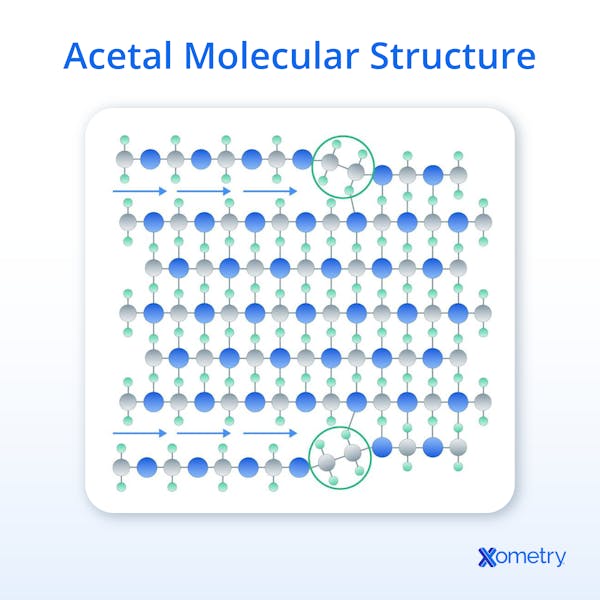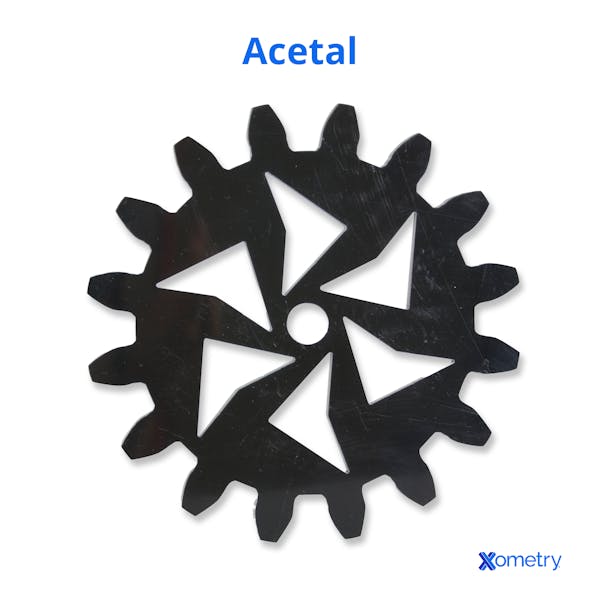Acetal is an organic molecule that is used in many different applications. One of the most common applications is in the manufacture of acetal polymers. Acetal polymers are available in two main forms, namely: acetal homopolymer (Delrin®) and acetal copolymer. Hemiacetal on the other hand is an organic molecule that is formed by the synthesis of acetal and is an unstable molecule that tends to favor the reaction from hemiacetal to acetal. Hemiacetal can, however, be found in nature including glucose and in some fungal species.
This article will compare acetal vs. hemiacetal by exploring the chemical makeup of both of these molecules and describing the chemical process that forms them.
What Is Acetal?
Acetal is an organic molecule that is formed through a process called acetalization. The acetalization process consists of reacting an aldehyde with alcohol while in the presence of an acid catalyst. Alternatively, alcohol and a ketone can be reacted together to form a ketal. These reactions are both reversible. During this reaction, hemiacetal is formed which, in the presence of excess alcohol, is transformed into acetal.
The acetal group consists of a carbon atom that is bonded to two OR (ether) groups, a group of R, and one of H. The general chemical formula is RHC(OR’)2. There can be symmetrical or mixed acetals as described below:
- Symmetrical Acetal Structure: When the two R groups are equal to each other
- Mixed Acetal Structure: When the two R groups are different
What Are the Characteristics of Acetal?
Acetal is more stable than hemiacetal as hemiacetals tend to form acetal when in the presence of excess alcohol. Acetals are stable with regards to hydrolysis caused by exposure to bases, oxidizing agents, and reducing agents. Acetal polymers have excellent mechanical properties and chemical resistance. When acetal molecules are exposed to an aqueous acid, they will hydrolyze back into their constituents.

What Are the Uses of Acetal?
Acetal and all its derivative forms are widely used in many different applications. The most common is in the polymerization of acetal copolymer and homopolymers. Some acetal examples are listed below:
- 1,1-Diethoxyethane: Produced by catalyzing ethanol and acetaldehyde. This has a pleasant odor and is used as a flavoring agent for some alcoholic beverages.
- Polyoxymethylene: Often abbreviated as POM. This is a thermoplastic polymer that is sometimes called acetal. Acetal polymers come in the form of a copolymer or a homopolymer (Delrin®) and exhibit excellent mechanical, thermal, and chemical resistance to inorganic and organic acids and solvents.
- Dioxolane: Formed through the acetalization of an aldehyde with ethylene glycol. Dioxolane is used as an electrolyte in lithium batteries or as a polymer solvent.
- Metaldehyde: Formed by reacting acetaldehyde with acids like hydrogen bromide. Paraldehyde is also formed during this reaction. Metaldehyde was originally used as a pesticide but was subsequently banned.
- Paraldehyde: Formed through the reaction of acetaldehyde with sulfuric acid. This chemical is used as a central nervous system depressant.
- 1,3,5-Trioxane: Formed through acid-catalyzed condensation of aldehydes. Trioxane is produced during the polymerization of polyoxymethylene (POM) plastics. It is also used in heat bars that are used to heat packaged survival meals.
- Dimethoxymethane: A dimethyl acetal derivative of formaldehyde. Dimethoxymethane is used primarily as a solvent as well as an additive for petrol that increases the octane number.

What Is Hemiacetal?
The synthesis of acetal produces hemiacetal, an intermediary organic molecule. This process is referred to as nucleophilic addition. Hemiacetal formation occurs when an aldehyde reacts with one equivalent of alcohol in the presence of an acid. A hemiketal, on the other hand, forms when alcohol reacts with a ketone in the presence of an acid.
What are the Characteristics of Hemiacetal?
Hemiacetal is an unstable compound formed by the synthesis of acetal. It is far more stable when formed into a cyclic hemiacetal. Hemiacetal can be naturally found in glucose and in some fungal species.
What Are the Uses of Hemiacetal?
Hemiacetal in its standard form is unstable and typically forms during the synthesis of acetal. As such it is an intermediate product. However, there exist forms of hemiacetal that can be found in nature. Some hemiacetal examples are listed below:
- Glucose and Fructose: In its cyclic form, hemiacetal can be found as a naturally occurring molecule in glucose, and hemiketals can be found in fructose. It must be noted that hemiacetal can be found in its non-cyclic form when glucose is dissolved in an aqueous solution. Glucose is the human body's main source of energy and is synthesized from food. Fructose is found naturally in fruits and is a basic ingredient in table sugar. Corn syrup also contains high levels of fructose.
- Mycorrhizin A: Cyclic hemiacetal molecules can be found in mycorrhizin A. This is an antibiotic that can be naturally found in a mycorrhizal fungus called Monotropa hypopitys L.
What Is the Difference Between Acetal and Hemiacetal?
On a purely chemical level, the difference between hemiacetal and acetal is as follows:
- The acetal molecule consists of a carbon atom bonded to two OR (ether) groups, a single group of R, and one of H.
- The hemiacetal molecule consists of a carbon atom bonded to one OR (ether) group with a single R and H group with an intramolecular OH group.
- Acetal is a stable molecule and hemiacetal is unstable.
However, when comparing acetal vs. hemiacetal, it is more accurate to say that the synthesis of acetal produces hemiacetal as an intermediate product.
Summary
This article contrasted acetal vs hemiacetal to illustrate what these two molecules are and the chemical process that forms them. To learn more about the details surrounding acetal vs. hemiacetal as well as how acetal polymers can benefit your specific application, contact us to connect to one of our materials specialists.
Xometry offers injection molding services for all of your prototyping and production needs. Visit our website to learn more and to request a free, no-obligation quote using our Instant Quote Engine.
Copyright and Trademark Notice
- Delrin® is a registered trademark of E.I. Du Pont De Nemours and Company, Wilmington, DE.
Disclaimer
The content appearing on this webpage is for informational purposes only. Xometry makes no representation or warranty of any kind, be it expressed or implied, as to the accuracy, completeness, or validity of the information. Any performance parameters, geometric tolerances, specific design features, quality and types of materials, or processes should not be inferred to represent what will be delivered by third-party suppliers or manufacturers through Xometry’s network. Buyers seeking quotes for parts are responsible for defining the specific requirements for those parts. Please refer to our terms and conditions for more information.

